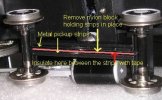maxi-model
UK/US/ROW steam narrow gauge railways 1:1
I've never used below R3R1 - 30 degree x 12 = 360
R2 - 30 degree x 12 = 360
R3 - 22.5 degree x 16 = 360
R5 - 15 degree x 24 = 360

I've never used below R3R1 - 30 degree x 12 = 360
R2 - 30 degree x 12 = 360
R3 - 22.5 degree x 16 = 360
R5 - 15 degree x 24 = 360

A part brick mounted on a loco did make me laugh, but point taken Re R1’s. We nearly all start out with them and some have more luck than others. Heck I have 3 quarter curves on my line, but always slow speed through them.And yes r1 track is a total pain in the butt. So I am warning others. It is ok for a siding maybe but not a main line.
Obviously reverse "S" bends with R1 exacerbate the issue.And yes r1 track is a total pain in the butt. So I am warning others. It is ok for a siding maybe but not a main line.
These trucks are inferior and need some work to make them better.
The spring on my one has little effect too.


